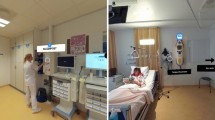Abstract
In an effort to better engage biomedical engineering technology (BMET) students with material covered in lectures and to connect them with their future careers, we created interactive 360° videos in typical BMET workplaces. Students watched the videos using virtual reality (VR) headsets and reflected on the experience. Students commented that the 360° videos made them feel that they were actually in the workplace and provided a better understanding of the devices that were covered in lectures. The use of interactive 360° videos proved to be an effective way for students to explore equipment and situations and has the potential to be more broadly applied in the biomedical engineering field.

Similar content being viewed by others
Data Availability
N/A.
Code Availability
N/A.
References
Saab M, Hegarty J, Murphy D, Landers M. Incorporating virtual reality in nurse education: a qualitative study of nursing students’ perspectives. Nurse Educ Today. 2021;105:105045.
Hanshans C, Faust M. Combining computer-based training, virtual, or augmented reality with peer teaching in medical and bio-technological education. In: 9th International Conference on Higher Education Advances. 2023. https://doi.org/10.4995/HEAd23.2023.16373
Steinke J, Applegate B, Penny J, Merlino S. Effects of diverse STEM role model videos in promoting adolescents’ identification. Int J Sci Math Educ. 2021. https://doi.org/10.1007/s10763-021-10168-z.
Lozano-Nieto A. New approaches for biomedical engineering technology & clinical engineering education: interactive video conferencing tools. J Clin Eng. 1998;23(2):117–21.
Lozano-Nieto A. Internship experiences in biomedical engineering technology: an overview of students and prospective employers perceptions. In: ASEE Conference. Seattle, Washington. 1998.
Marhefka J, Park D, Cruz L. Ready, set, go: fostering student success in an introductory biomedical engineering technology course. In: FYEE Conference. Virtual. 2020.
DiNatale AF, Repetto C, Riva G, Villani D. Immersive virtual reality in K-12 and higher education: a 10-year systematic review of empirical research. Br J Educ Technol. 2020;51(6):2006–33.
Jiang Y, Popov V, Li Y, Myers P, Dalrymple O, Spencer J. ‘It’s Like I’m Really There’: using VR experiences for STEM career development. J Sci Educ Technol. 2021;30:887–8.
Spangenberger P, Freytag S. Career choice of adolescents: can occupational VR 360-degree videos facilitate job interest? In: Proceedings of the 12th international conference on computer supported education (CSEDU 2020). 2020. pp. 552–58.
Mead C, Buxner S, Bruce G, Taylor W, Semken S, Anbar A. Immersive, interactive virtual field trips promote science learning. J Geosci Educ. 2019;67(2):131–42.
Sultan L, Abuznadah W, Al-Jifree H, Khan M, Alsaywid B, Ashour F. An experimental study on usefulness of virtual reality 360 in undergraduate medical education. Adv Med Educ Pract. 2019;10:907.
Violante M, Vezzetti E, Piazzolla P. Interactive virtual technologies in engineering education: why not 360° videos? Int J Interact Des Manuf. 2019;13(2):729–42.
Makransky G, Peterson G, Klingenberg S. Can an immersive virtual reality simulation increase students’ interest and career aspirations in science? Br J Educ Technol. 2020;51(6):2079–97.
Brame C. Effective educational videos. 2015. http://cft.vanderbilt.edu/guides-sub-pages/effective-educational-videos/. Accessed 22 Feb 2024.
Carmichael M, Reid A, Karpicke J. Assessing the impact of educational video on student engagement, critical thinking and learning [White paper]. Sage Publishing; 2018. Available from: https://us.sagepub.com/sites/default/files/hevideolearning.pdf.
Harvard Graduate School of Education - Project Zero. n.d. See, think, wonder. See, Think, Wonder Thinking Routine. https://pz.harvard.edu/resources/see-think-wonder. Accessed 9 May 2023.
Shadiev R, Yu J, Sintawati W. Exploring the impact of learning activities supported by 360-degree video technology on language learning, intercultural communicative competence development, and knowledge sharing. Front Psychol. 2021. https://doi.org/10.3389/fpsyg.2021.766924.
Feurstein M. Exploring the use of 360-degree video for teacher-training reflection in higher education. In: Proceedings of DELFI Workshops, Berlin, Germany. 2019.
Chan V, Larson N, Moody D, Moyer D, Shah N. Impact of 360° vs 2D videos on engagement in anatomy education. Cureus. 2021. https://doi.org/10.7759/cureus.14260.
Funding
The Teaching and Learning with Technology unit at Penn State provided funding for the 360° video camera, as well as, continued funding of Thinglink™ (https://www.thinglink.com/) which has a subscription pricing model.
Author information
Authors and Affiliations
Contributions
N/A.
Corresponding author
Ethics declarations
Conflict of interest
The authors have no relevant financial or non-financial interests to disclose.
Ethical Approval
Approval of this work as an exempt study was obtained from the institutional review board at the Pennsylvania State University IRB STUDY00018895.
Consent to Participate
N/A.
Consent for Publication
N/A.
Rights and permissions
Springer Nature or its licensor (e.g. a society or other partner) holds exclusive rights to this article under a publishing agreement with the author(s) or other rightsholder(s); author self-archiving of the accepted manuscript version of this article is solely governed by the terms of such publishing agreement and applicable law.
About this article
Cite this article
Marhefka, J.N., Campbell, S., Kuntz, A. et al. Coming Full Circle: The 360° Experience for Biomedical Engineering Technology Students. Biomed Eng Education (2024). https://doi.org/10.1007/s43683-024-00152-8
Received:
Accepted:
Published:
DOI: https://doi.org/10.1007/s43683-024-00152-8




